Disclosure: This post may contain affiliate links. I may earn a small commission for my endorsement, recommendation, testimonial, and/or link to any products or services from this website.
Baked Shrimp with Tomatoes and Feta is an easy and healthy dinner that’s full of Mediterranean flavor! This traditional Greek dish pairs nicely with rice, pasta, or a crusty loaf of bread.
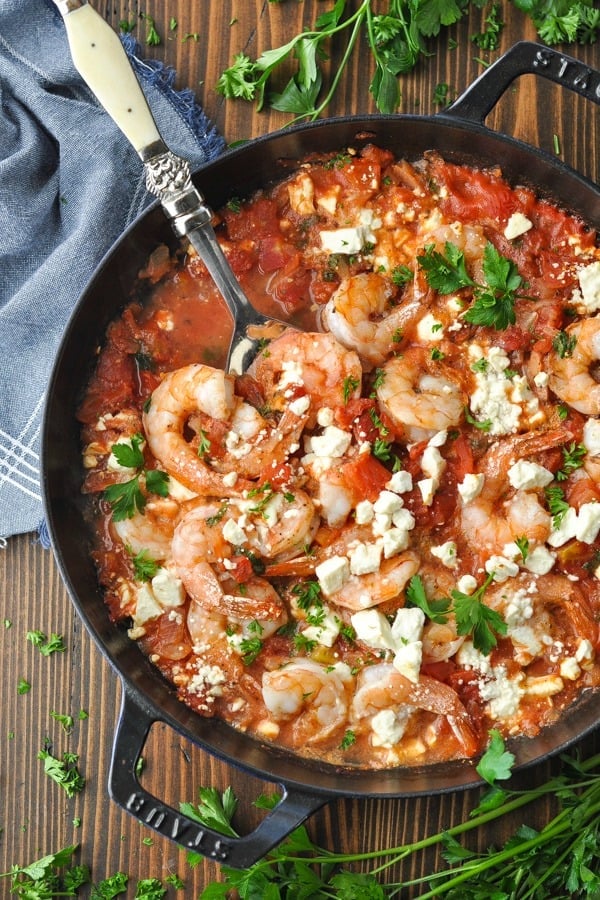
Table of Contents
- The Greek Origins of Shimp and Tomatoes with Feta
- Ingredients for Savory Shrimp and Tomatoes
- How to Make Baked Shrimp with Tomatoes and Feta
- What to Serve with Greek Shrimp and Tomatoes with Feta
- How to Store Baked Shrimp and Tomatoes
- Shrimp and Tomatoes with Feta Recipe Tips and Variations
- More Baked Shrimp Recipes to Try
- Baked Shrimp with Tomatoes and Feta Recipe
My mom has been serving this baked shrimp recipe for as long as I can remember. I have no idea where she originally found the idea (maybe an old Cooking Light magazine?), but it has become a staple in my home as well. It’s an easy way to prepare seafood in the kitchen when the weather outside isn’t ideal for grilling. Plus, even the kids enjoy the fresh Mediterranean flavors!
The Greek Origins of Shimp and Tomatoes with Feta
While this recipe was a staple of my childhood, it turns out that it’s also a classic Greek recipe. My shrimp and tomatoes with feta recipe is remarkably similar to shrimp saganaki – a delicious dish with succulent shrimp and Mediterranean flavors of fresh herbs, lemon, and olives. My easy recipe simplifies the dish a bit but still provides those same delicious flavors. It’s perfect paired with a glass of white wine (goes best with shrimp), some homemade crusty bread, and a traditional Greek salad on the side.

Ingredients for Savory Shrimp and Tomatoes
This simple, rustic dinner starts on the stovetop and then finishes in the oven, so you’ll want to use an ovenproof skillet. I use my trust cast iron skillet, but any oven-safe large skillet will suffice. Let’s get started with an overview of the ingredients. You can find the full ingredients and directions in the printable recipe card at the bottom of the post.
- Onion & Garlic: aromatics for flavor in the hearty tomato sauce.
- Canned Petite-Diced Tomatoes: the base of the dish. If you prefer to make a homemade fresh tomato sauce, you certainly can.
- White Wine: gives a depth of flavor to the sauce. You’ll want to use a dry white wine like Pinot Grigio or Sauvignon Blanc.
- Parsley & Basil: these fresh herbs simmer in the sauce, adding so much flavor.
- Italian Seasoning: even in a Greek-inspired dish, the bold flavors of Italian herbs pair perfectly with shrimp and tomatoes.
- Shrimp: the star of the show! We prefer fresh jumbo shrimp, peeled and deveined.
- Feta Cheese: salty feta cheese is the perfect touch of Greek flavor in this recipe.
Can I use frozen shrimp instead of fresh shrimp?
You absolutely can use frozen shrimp in this quick weeknight meal! You’ll want to make sure the shrimp is fully thawed ahead of time before cooking. Additionally, if you don’t have jumbo shrimp, large shrimp (the typical-sized shrimp) is fine. Cooking time will adjust depending on the size of your shrimp, and you don’t want to overcook this quick-cooking shellfish!
What’s the best type of shrimp to use for baked shrimp saganaki?
For convenience, I prefer (and recommend) buying already peeled and deveined shrimp, but it’s not hard to prep the raw shrimp yourself if necessary. You’ll first need to remove the head, legs, and shell of the shrimp. Then use a paring knife to remove the vein along the outside edge of the shrimp. Rinse the prepared shrimp under cold water once clean before proceeding.
In terms of size, this shrimp dish is best made with larger shrimp, so they stay tender and juicy through the cooking process. The count of shrimp per pound is usually indicated on the bag – jumbo shrimp usually come with 20-25 shrimp per pound, large shrimp have 30-35, and medium shrimp have 40-50 shrimp per point. The smaller the shrimp, the shorter the cooking time.
How to Make Baked Shrimp with Tomatoes and Feta
This easy weeknight dinner is healthy eating made simple. With Greek roots, tons of flavor, and simple ingredients, you can’t go wrong!
- Prepare the tomato sauce mixture by cooking onion, garlic, and tomatoes in a large oven-proof skillet on the stovetop.
- Stir in the herbs and shrimp, then sprinkle the crumbled feta cheese over top.
- Bake the dish in a 425-degree oven for 12-15 minutes or until the shrimp are cooked through and the cheese melts.
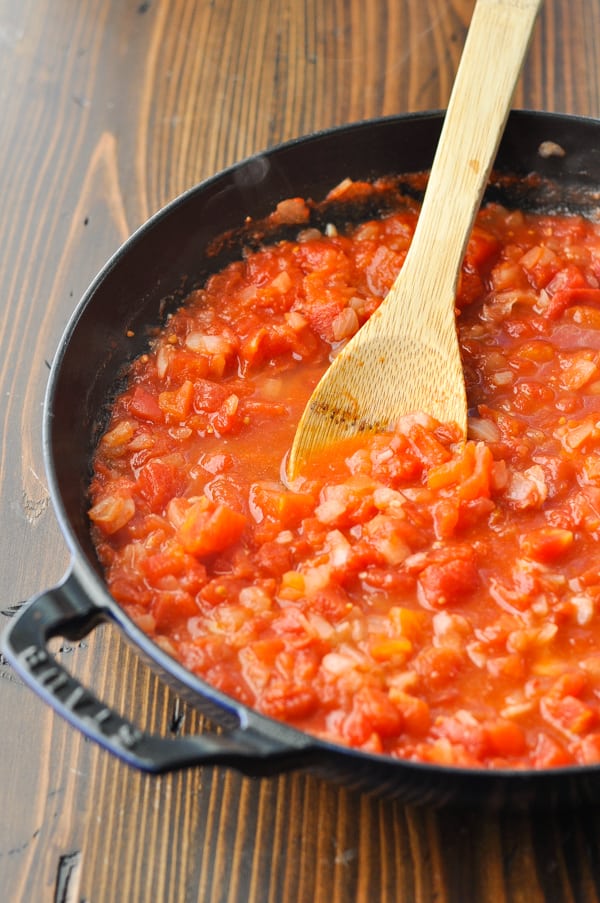
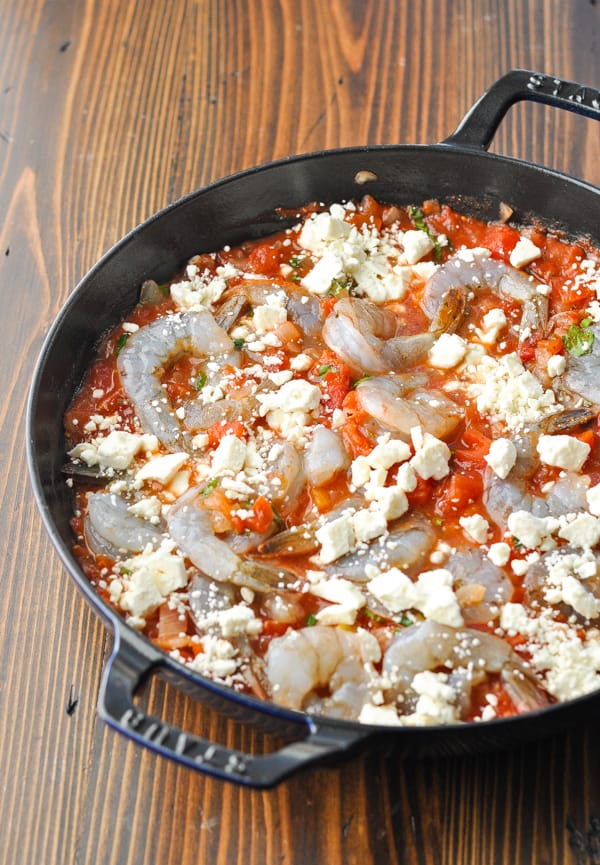
How to Make a Homemade Tomato Sauce for Shrimp Saganaki
Using canned tomatoes takes a lot of the prep work out of this already simple recipe. If you want a more homemade flavor, you can easily make a homemade tomato sauce with fresh tomatoes. You’ll need 3-4 pounds of fresh tomatoes – Roma or Campari tomatoes are best, but whatever kind is affordable and ripe can work.
Canned tomatoes are peeled before canning, so if you want a similar texture with homemade flavor, you’ll want to score, boil, blanch, and peel the tomatoes before crushing them into a textured, chunky sauce. From that point, the directions are very the same! Season the sauce with salt and black pepper, and simmer it with the onions, fresh garlic cloves, and herbs for flavor.
Traditional Spicy Tomato Sauce
The traditional recipe for Shrimp Saganaki uses a spicy tomato sauce, which can be achieved with the seasonings – red pepper flakes, cumin, and even a pinch of cayenne will pack a light heat without overpowering the dish.
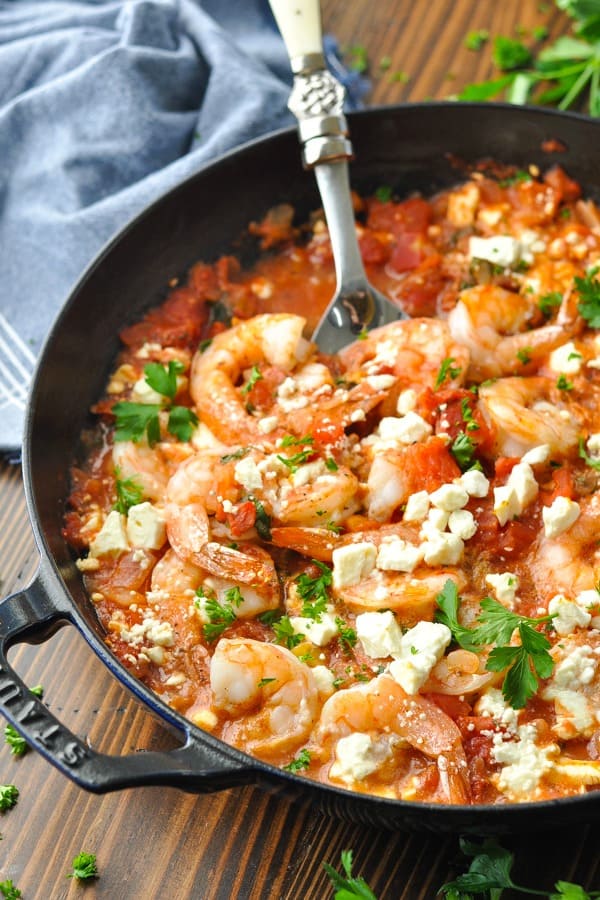
What to Serve with Greek Shrimp and Tomatoes with Feta
This Mediterranean-inspired dish goes well with rice, quinoa, couscous, orzo, or pasta. For a really easy and delicious option, just offer a loaf of warm, crusty sourdough bread on the side to soak up that great tomato sauce. A simple, fresh side salad is another great option. Here are some more simple sides to round out this healthy dinner:
- Rice Pilaf
- Cucumber Tomato Onion Salad
- Dutch Oven Bread {No Knead!}
- Roasted Yellow Squash
- Greek Salad with Shrimp (just omit the shrimp)
- Green Salad with Red Wine Vinaigrette
- Wedge Salad Recipe
- Couscous Salad
- Crispy Parmesan Potatoes
- Sautéed Zucchini
- Bacon Wrapped Asparagus
- Rosemary Roasted Potatoes
- Parmesan Roasted Cauliflower
- Sautéed Asparagus with Garlic and Lemon
How to Store Baked Shrimp and Tomatoes
Leftovers should be kept in an airtight container in the fridge and are good for 2-3 days. The easiest way to reheat leftover shrimp and tomatoes is on a large skillet on the stovetop over medium heat until warmed through. You’ll want to use lower heat to avoid overcooking the shrimp. Add more crumbled feta towards the end of reheating, and you’re all set!
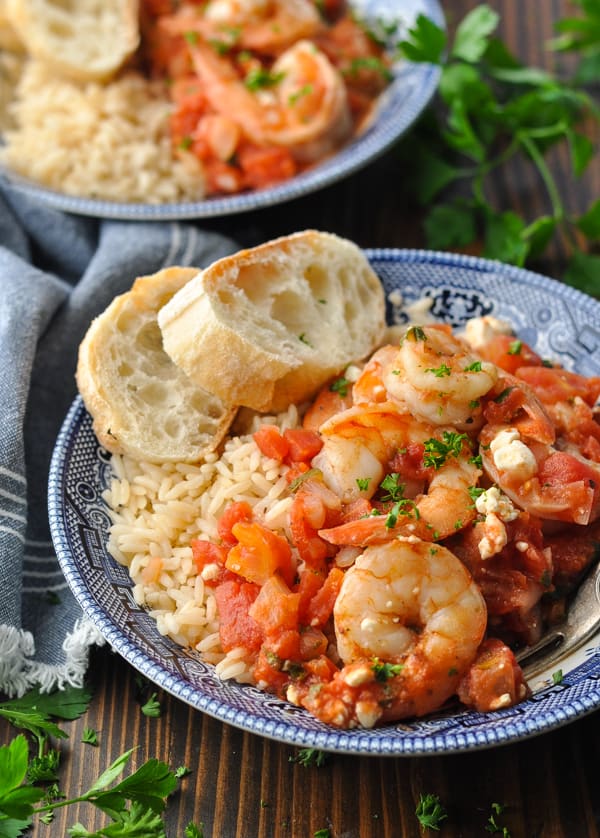
Shrimp and Tomatoes with Feta Recipe Tips and Variations
- You can use fresh or frozen shrimp for this recipe. If starting with frozen shrimp, allow the shrimp to thaw in the refrigerator overnight or place them in a colander and run under cold water until thawed.
- I like Jumbo shrimp, but any size shrimp will work here. Just adjust the baking time according to the size of your shrimp (smaller shellfish will cook faster).
- You can tell that the shrimp are done when they are opaque white with some pink and red accents. Keep an eye on them because shrimp can become overcooked very quickly, and then they will have an undesirable, tough texture.
- Feel free to mix up the herbs in this dish. I’ve used parsley and basil, but oregano and/or thyme would also be nice additions!
- Lean into the Mediterranean flavors of classic Shrimp Saganaki by adding more traditional ingredients like kalamata olives, red onion, and fresh lemon.
- Garnish the fish with fresh parsley, lemon zest, and a spritz of fresh lemon juice to enhance the flavors of the tender shrimp and tomatoes even further.
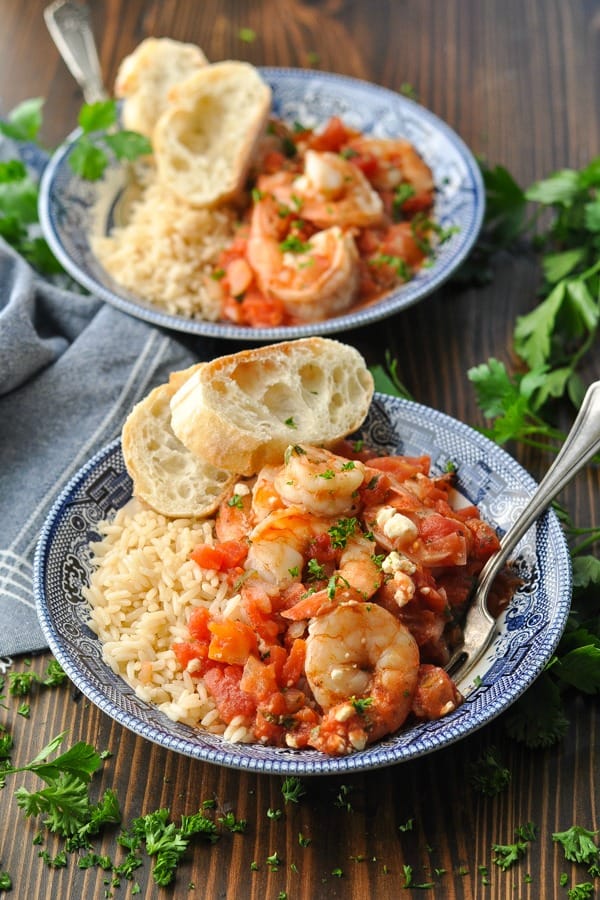
More Baked Shrimp Recipes to Try

Baked Shrimp with Tomatoes and Feta
Ingredients
- 1 tablespoon olive oil
- 1 cup diced onion
- 2 teaspoons minced garlic
- 2 cans (14.5 ounces each) petite-diced tomatoes NOT drained
- ¼ cup white wine
- 1 tablespoon minced fresh parsley
- 1 tablespoon minced fresh basil
- 16 ounces raw Jumbo shrimp peeled and deveined
- ½ teaspoon Italian seasoning
- ½ teaspoon salt
- ¼ teaspoon pepper
- 1 (3.5 ounce) container crumbled feta cheese
- Optional, for serving: pasta, rice, or crusty bread
Instructions
- Preheat oven to 425 degrees F. Heat oil in a large, oven-proof skillet over medium-high heat.1 tablespoon olive oil
- Add onion and cook, stirring frequently, until softened (about 3 minutes).1 cup diced onion
- Add garlic, cook for 1 minute. Add tomatoes and their juice, as well as the wine. Bring to a boil. Reduce heat to medium-low and let sauce simmer for about 5-10 minutes, or until juices thicken slightly.2 teaspoons minced garlic, 2 cans (14.5 ounces each) petite-diced tomatoes, ¼ cup white wine
- Remove skillet from burner. Stir in parsley, basil, Italian seasoning, shrimp, salt and pepper. Sprinkle feta over top.1 tablespoon minced fresh parsley, 1 tablespoon minced fresh basil, 16 ounces raw Jumbo shrimp, ½ teaspoon Italian seasoning, ½ teaspoon salt, ¼ teaspoon pepper, 1 (3.5 ounce) container crumbled feta cheese
- Place skillet in the oven; bake until shrimp are cooked through (about 12-15 minutes).
Notes
- You can use fresh or frozen shrimp for this recipe. If starting with frozen shrimp, allow the shrimp to thaw in the refrigerator overnight or place them in a colander and run under cold water until thawed.
- I like Jumbo shrimp, but any size shrimp will work here. Just adjust the baking time according to the size of your shrimp (smaller shellfish will cook faster).
- You can tell that the shrimp are done when they are opaque white with some pink and red accents. Keep an eye on them because shrimp can become overcooked very quickly, and then they will have an undesirable, tough texture.
- Feel free to mix up the herbs in this dish. I’ve used parsley and basil, but oregano and/or thyme would also be nice additions!
- Lean into the Mediterranean flavors of classic Shrimp Saganaki by adding more traditional ingredients like kalamata olives, red onion, and fresh lemon.
- Garnish the fish with fresh parsley, lemon zest, and a spritz of fresh lemon juice to enhance the flavors of the tender shrimp and tomatoes even further.


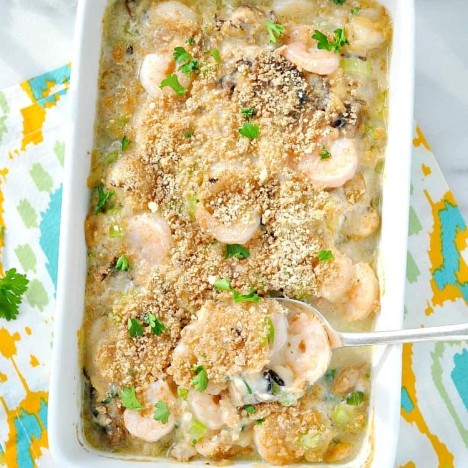


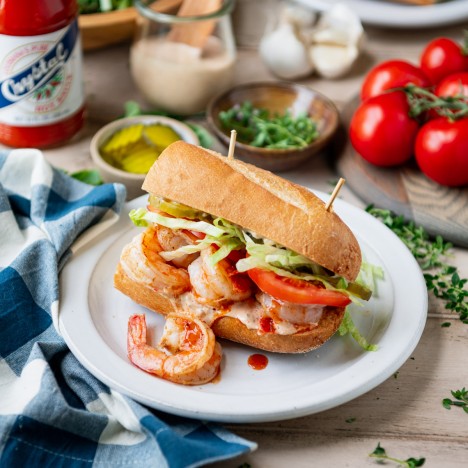













Love shrimp. Can’t wait to try this.
Robin
Me too. Sounds so good.